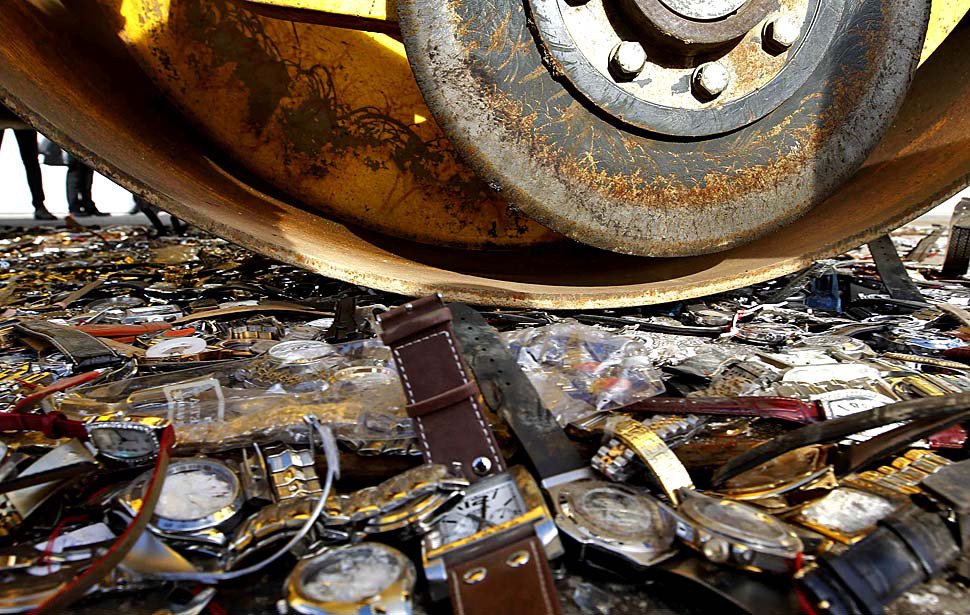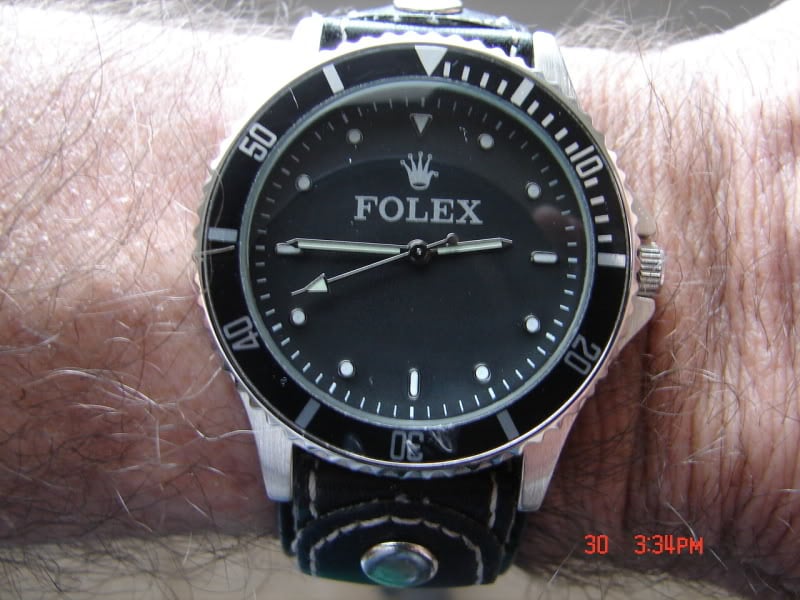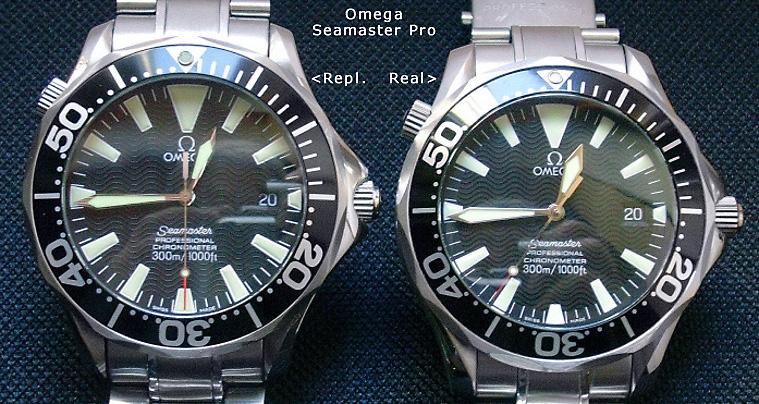When I was about 8, I discovered a way to make as much money as I could dream of.
I went to the store, put as much candy as I could carry on the counter, and pulled out my velcro wallet stuffed to the brim with £5 notes.
There was one problem…I made them with a photocopier. Turns out that fake isn’t as good as the real thing – who knew?
While photocopying cash might seem like an obviously silly thing to do as an adult, many get tricked into walking around with a fake watch on display.
There are many problems with fake watches, and ultimately, they are a waste of money. I’ll walk you through the seedy watch world underground and show you how you can avoid becoming a victim of deceit.
How Can a Watch Be “Fake”?

The term fake can be confusing to some. If it’s not obvious what a fake watch is to you, think of it more as a replica. These are watches that are designed to look like popular watches from leading brands.
While they often come quite close to the look, that’s about the only thing they have going for them. These watches are made illegally by individuals or small companies. They are sold on the Internet, or often at flea markets and street booths.
The price of fake watches varies from £10 up to the thousands, but the most common price is around £100. These replicas look like watches that would cost many multiple times their price.
If the reason you wanted a fake watch is purely because of price, you really need to check out our buying guide of watches between £100-300. They look better than knockoffs, last way longer, and actually work the way they’re supposed to.
Why You Shouldn’t Buy a Fake Watch
After you read through the rest of this guide, you’ll know exactly how to spot a knock-off watch. However, you still might be tempted to buy one. After all, who wouldn’t want a Rolex for a few hundred pounds?
But here’s the problem (well…problems): the watch wasn’t made in the same way or often even without the same material as the real thing. That color’s likely going to fade quickly, the watch is only going to function for a few years, and it might even fall apart before that.
All in all, it’s not going to look good for long. Do you really want an unattractive, obviously fake watch that isn’t even reliable? The answer for the vast majority of people is no, and I hope that’s yours as well.
Telltale Signs of Fake Watches

There are many ways to spot a fake, some are easier than others. It really comes down to your eye for detail. Most fake watches will have more than one aspect that is “off”, so don’t worry if you miss one.
1. Incorrect logos and watch face details
The small details are where fakes are typically the most obvious. It could be anything from the logo being slightly off (a big red flag), missing a label, or having the wrong hour markings around the face. The most common mistakes are having the wrong fonts (typefaces), and sometimes there are even typos.
2. Mixed and matched parts
It’s fairly common for manufacturers of fake watches to accidentally use the wrong parts altogether for a replica. Remember, most of these organizations are not highly sophisticated. Look for the color and shape of the hands, bracelet, and dial.
3. Missing features
One of the biggest red flags is if a chronograph doesn’t work. Sometimes a crown doesn’t work, is in the wrong spot, or doesn’t work altogether
4. It feels off
One of the signature aspects of most high quality watches is a distinctive feel on your wrist. The weight and comfort are fairly difficult to replicate. It’s worth going to a store that you are 100% confident is legitimate to try on different watches. Note how each one feels so that you can compare any “discounted” watches you come across.
5. Ridiculous price
If you’re looking at luxury watches, look online before you buy anything. If someone want to sell you a Rolex for £200, there’s something fishy going on. A discount isn’t necessarily a red flag, but if it’s anything more than 20-25%, start getting cautious. If something seems too good to be true, it probably is.
6. Sound
All watches have a slightly different sound than each other. However, top quality watches are usually very quiet, so if you come across a watch that is particularly noisy, something is clearly up. The internal mechanisms of fake watches are usually poorly made, and sound is one indication of this.
How to Avoid Buying a Fake Watch
So now that you have a decent idea of what you’re looking for, you can probably spot a fake. However, some replicas are very convincing. Look at this comparison of a real Omega watch beside a replica (Click to enlarge):

This is a very good fake. The only differences are a slightly wider dial, and slightly wrong spacing of the main writing underneath the center.
This is why, whenever possible, you should avoid situations where you could come across fakes. Here are the 3 main parts of a strategy that will protect you as much as possible when buying a new watch.
1. Buy From Authorized Dealers
Watch manufacturers only allow certain companies to sell their products directly on the Internet; these are called “Authorized Dealers”. Be aware of companies that are not authorized dealers; they could be getting their watches from a number of sources, some of which may be questionable.
2. Buy From Trusted Stores
Technically, any website could steal the authorized dealer image or text and put it on their website. They would face legal action if caught, but might get away with it for a while. This is why this step is so crucial. If you stick to a trusted source, you’ll never have issues. Beyond just getting an authentic watch, you’ll also get better customer service.
If you’ve just started getting interested in watches, you likely don’t know too many trusted stores. In that case, there’s a few things you should look for when going to a new site for the first time.
Start by examining their reviews. Most watch stores have user reviews enabled, so that customers can post about their experiences and purchases. You should be looking for a high amount of positive reviews. Furthermore, don’t just look at the rating, but read the comments as well. Look for comments about being a long-time visitor, getting their delivery quickly, and being happy overall with their purchase.
Additionally, you can look at how old the business is. Most will have an established date somewhere on the site, but you can also use Archive.org in order to see when they first had an online shop created.
3. Do Your Due Diligence
Most quality watches cost as much as the latest smartphone, sometimes even more. This isn’t a purchase that should be rushed if you don’t feel comfortable.
The first part of due diligence is to determine which watches you are most interested in. Unless it’s a vintage watch, chances are you’ll be able to find the exact model you’re looking for, so feel free to narrow down your choices.
Your next step is to shop around to find a good price and good service that you can trust. This is pretty easy online (check out the search function in our store). If you’re not sure which watch you’re interested in, it’s easy to filter by price, brand and type of watch.
If you’d prefer to buy in-person, you may have a more difficult time. Again, you want to shop at a trusted watch dealer. You can look at the store’s website to get an indication of their trustworthiness. If it’s a sketchy looking store with no website (or a poor one), stay away.
That just leaves street vendors and pawn shops really. While I can’t stop you from buying a watch from them, I would like to highly recommend steering clear. This is where fake watches are most common. If you’re really tempted by an offer, think it through. Sellers of fake watches will often try to pressure you into buying by offering a limited time discount, but only if you buy right now.
Additionally, look for all those indicators of fake watches that we went over before. If you have time, go compare the feel of the same watch from a local store that you know you can trust.
Special Case: Vintage Watches
Many, but not all, vintage watches will have a certificate of authenticity. If there is a certificate that comes with it, you can feel a little safer about it. Technically, the certificate could be forged as well, but most fake watch sellers would rather just sell the watch without it. Serial numbers should match between the certificate and the watch.
Additionally, most vintage watches have some sort of paperwork that outlines who past buyers were. While there’s not always a certificate of authenticity, there should be some paperwork.
Last Remarks on Buying a Watch Safely
I know all this sounds a bit scary, but as long as you stick to a reputable seller, you’ll likely never have to deal with fake watches. However, this knowledge might come in handy if a friend ever gets him/herself into trouble.




